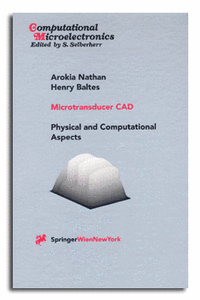Book Information

Microtransducer CAD. Physical and Computational Aspects
- Author: Nathan, Arokia; Baltes, Henry
- Published: 1999, 427 pages, 137 figures
- ISBN: 978-3-7091-7321-3 (Hardcover), 978-3-7091-6428-0 (eBook)
- Information from Amazon
Abstract:
Computational Microelectronics ISSN 0179-0307 Computer-aided-design (CAD) of semiconductor microtransducers is relatively new in contrast to their counterparts in the integrated circuit world. Integrated silicon microtransducers are realized using microfabrication techniques similar to those for standard integrated circuits (ICs). Unlike IC devices, however, microtransducers must interact with their environment, so their numerical simulation is considerably more complex. While the design of ICs aims at suppressing "parasitic" effects, microtransducers thrive on optimizing the one or the other such effect. The challenging quest for physical models and simulation tools enabling microtransducer CAD is the topic of this book. It is intended as a text for graduate students in Electrical Engineering and Physics and as a reference for CAD engineers in the microsystems industry. This text evolved from a series of courses offered to graduate students from Electrical Engineering and Physics. Much of the material in the book can be presented in about 40 hours of lecture time. The book starts with an illustrative example which highlights the goals and benefits of microtransducer CAD. This follows with a summary of model equations describing electrical transport in semiconductor devices and microtransducers in the absence of external fields. Models treating the effects of the external radiant, magnetic, thermal, and mechanical fields on electrical transport are then systematically introduced. To enable a smooth transition into modeling of mechanical systems, an abridged version of solid structural and fluid mechanics is presented, whereby the focus is on pertinent model equations and boundary conditions. This follows with model equations and boundary conditions relevant to various types of mechanical microactuators including electrostatic, thermal, magnetic, piezoelectric, and electroacoustic. The book concludes with a glimpse into SPICE simulation of the mixed-signal microsystem, i.e., microtransducer plus circuitry. Where possible, the model equations are supplemented with tables and/or graphs of process-dependent material data to enable the CAD engineer to carry out simulations even when reliable material models are not available.
